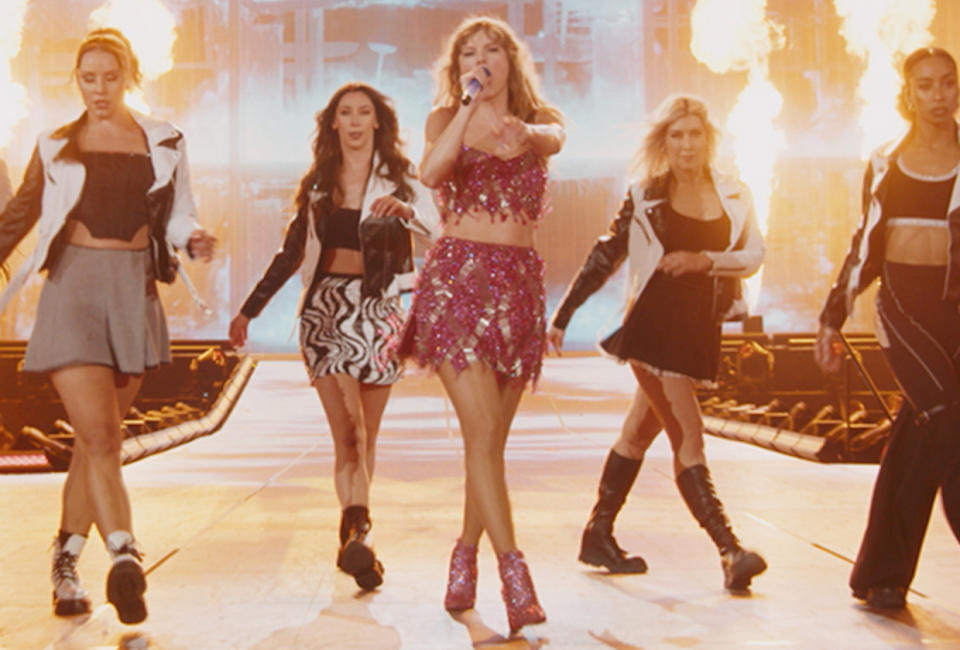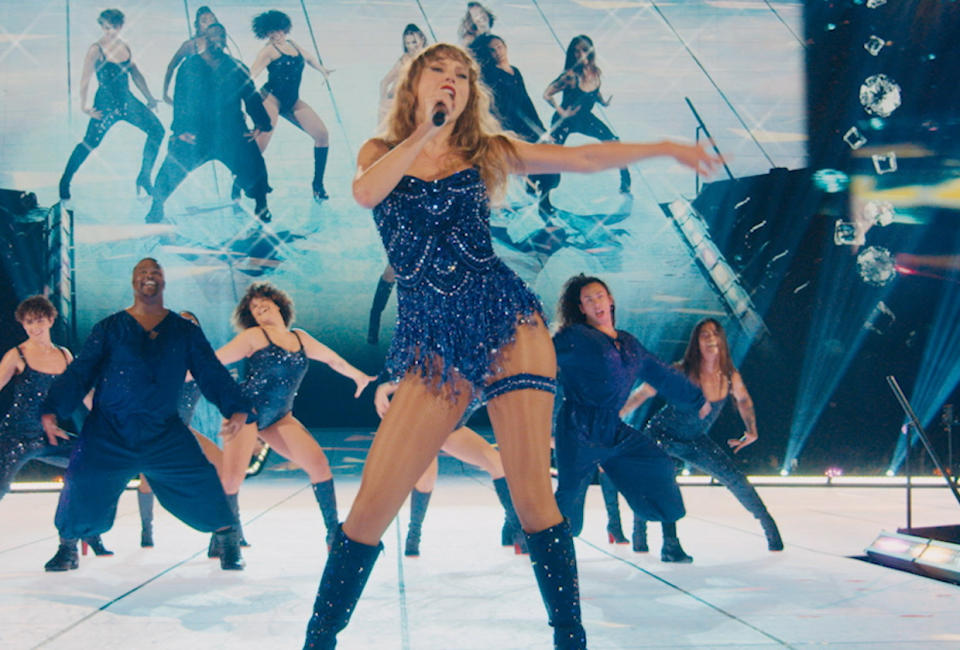The Eras Tour Hits Different on TV — What the Taylor Swift Concert Loses (and Gains) on Disney+
Taylor Swift: The Eras Tour makes its streaming debut on Disney+ Thursday, and, at first, it won’t quite measure up to the stadium experience.
In May 2023, my five closest friends and I attended Swift’s show at MetLife Stadium — and it wasn’t just a concert. For a group of single twenty-something women, it was, in many ways, our wedding, our bachelorette party and maybe even our own funeral! What I mean is, it was a ritualistic occasion — a holy sacrament.
More from TVLine
Taylor Swift's Eras Tour Debuts as Disney+'s No. 1 Music Film, With Nearly 5 Million Views
'Someone's Killing Jedi' in Star Wars: The Acolyte Trailer - Watch, Get Disney+ Release Date
Doctor Who Sets Release Date for XL Season 14 Premiere; UK to Get Episodes 'Next Day'
For us, the Eras Tour wasn’t simply an after-work get-together, it was a grand, all-day affair. Brunch was had, toasts were made. Dresses were steamed, lipsticks were traded. Glitter was swiped onto eyelids, cheeks and chests. And, of course, Eras were selected and embodied in fishnet tights and gauzy purple dresses.
We took several high-speed and low-speed trains to get there — “there” being a New Jersey football arena that had metamorphosed into a mecca of girlhood. Despite MetLife Stadium being packed with thousands and thousands of individual fans, we all vaguely resembled the same person and our particulars washed away, for better or for worse. That night, we were Swifties.
When Swift finally emerged from the dramatic water-colored fans and took the stage, our brain chemistries were altered — whether by the sheer force of the vibration in the stands or the simple coming of Mother remains unclear.
Despite our position in $140 seats in the fourth-to-last row, we could feel her power and her control over the crowd. She commanded the massive stage and surrounding stadium, even while playing the notably low-key acoustic surprise songs (which were, that night, the glorious “False God” and the dubious “Holy Ground”).

But on Thursday, Disney+ subscribers will face the same hard truth as I did when I rented the concert movie on Prime Video in December: Swift’s magic was not what I thought. I felt duped! Where in concert she was huge, on TV she is small. Where on tour she spoke to hundreds of thousands, on screen she’s just talking to little old me. In all honesty, though it pains me as a Swiftie to admit, I found myself cringing at the pop icon’s just average ability to move about the stage.
But as a card-carrying member of the Swiftie Union, I kept watching and I realized I recognized the pop star’s dancing. When examined in documentary-style close-ups, I discovered that the woman isn’t dancing at all! Swift is merely hand-dancing, orchestrating a series of musical charades corresponding to actions in her lyrics.
In case you haven’t heard of the totally made-up art of hand-dancing, it’s the most common form of artistic expression among rhythmically averse young girls — it sometimes even follows us into young adulthood at school dances, weddings and holiday soirées. It’s the flip of the hair in “Shake It Off,” it’s the hand-on-the-wheel motion in “You Belong With Me,” it’s the tossing of the car keys in “All Too Well” and the finger phone in “We Are Never Getting Back Together.”
Even when Swift’s actions aren’t obviously interpretative, her upper limbs are always grooving, like in “Illicit Affairs,” when she flips her flowy, chiffon sleeves in the wind like her hands are ribbon-dancing machines. And before I knew it, I was singing along and slamming my own hands onto my coffee table, demanding some man of my yesteryear to quit calling me kid, stop calling me baby. And my red palms and stretched vocal cords were proof: I was captivated.

Swift’s moves are comprised of the kind of gestures that, for most girls, aren’t typically performed outside of the gaze of our mascara-stained mirrors. And this is no flaw — nor an accident. Swift’s stratospheric power is fueled by these pantomimes of girlhood because they express a certain girlish, interior grandiosity that, under Swift’s direction, can miraculously birth football-stadium sovereignty and on-screen intimacy.
Girlhood, when performed collectively, feels so mighty. But it becomes so small sitting on a second-hand couch in an overpriced and undersized New York City apartment. Girlhood is the contradicting sensation that we are at once important and exceptional, but also small and forgettable. And the Eras Tour understands this. Swift knows how to channel the major emotions of minor events into a performance that isn’t about singing and dancing at all, but about tapping into the collective nostalgia of particular experiences that share a common essence.
In person, these performances work because Swift feels otherworldly when surrounded by a swarm of ritualistic fans egging each other on and gassing each other up. On TV, with no one else is around, the knee-jerk response to the Eras Tour is embarrassment. She’s a little too much like us and we can’t help but think, Girl, stop playing with your hair! Quit crying over that boy! Get over it, already! But Swift’s relentless hand-dancing and straightforward lyrics ultimately invite us into a more intimate mode of introspection — something that can’t be done amid the pomp and circumstance of an in-person concert. On screen, her performances conjure images of real heartbreak and real vulnerability, and for a few hours, we get to feel cathartically small — we don’t need to arm ourselves with lipstick, glitter and cupcake-shaped dresses to prove our interior lives are worth something.
It becomes validating to watch the biggest pop star of all time prance around an enormous stage, in front of a gigantic crowd, to the beat of the loudest rhythms using the most rudimentary expressions of adolescence to actually entertain. She’s actually doing the thing we all pretended to do after school when no one was home, singing into a hairbrush or the handle of a Swiffer WetJet, lamenting about all the ways we’ve been wronged by boys and our various arch nemeses — and it’s celebrated. It’s not pathetic, or secret, or embarrassing.
Swift is us and Swift is ours, and it’s more clear than ever when viewed up close on TV from home — you just have to be willing to wait out the cringe.
Best of TVLine
The Best Streaming Services in 2024: Disney+, Hulu, Max and More
What's New on Netflix in January — Plus: Disney+, Hulu, Amazon and Others
Get more from TVLine.com: Follow us on Twitter, Facebook, Newsletter


